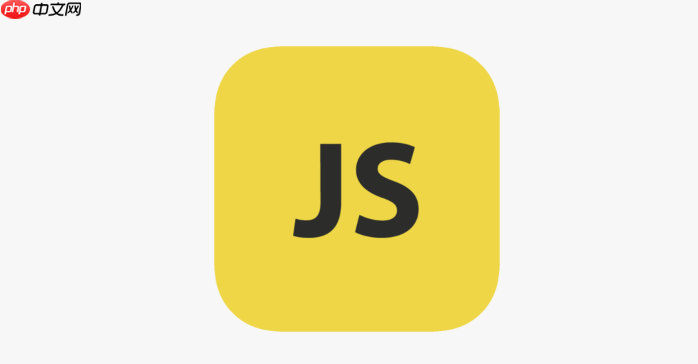实现 JavaScript 数组动画过渡的关键是使用 requestanimationframe 创建平滑的动画循环,优先于 setinterval 因其与屏幕刷新率同步、性能更优;1. 使用 requestanimationframe 在每一帧中逐步更新数组元素值,结合初始值与目标值之间的差值计算当前进度;2. 引入缓动函数(如 easeinout)对进度进行加权处理,使动画过渡更自然;3. 对于包含对象等复杂结构的数组,需递归遍历属性并分别执行属性级别的动画;4. 为避免副作用,建议操作数组副本并在动画完成后统一更新视图。整个过程需确保在规定时间内完成插值计算并持续回调视图更新函数,直至动画结束,最终实现流畅的数组状态过渡。

实现 JavaScript 数组动画过渡,关键在于理解动画的本质:在一段时间内,平滑地改变数组的元素值,并在每次改变后更新视图。

解决方案:
要实现数组的动画过渡,核心思路是利用
requestAnimationFrame
或
setInterval
创建一个动画循环,并在循环中逐步改变数组的元素值。 可以选择线性过渡、缓动函数等方式控制过渡效果。
立即学习“Java免费学习笔记(深入)”;

如何选择合适的动画循环方式?
requestAnimationFrame
requestAnimationFrame
vs
setInterval
requestAnimationFrame
的优势在于它会根据浏览器的刷新率进行优化,通常是每秒 60 帧,能提供更流畅的动画体验。它在浏览器空闲时执行回调,避免阻塞主线程,从而减少卡顿。而
setInterval
则按照固定的时间间隔执行回调,可能会导致动画不流畅,尤其是在浏览器负载较高时。所以,优先选择
requestAnimationFrame
。
function animateArray(arr, targetArr, duration, callback) { const startTime = performance.now(); const initialArr = [...arr]; // 创建初始数组的副本 const diffArr = targetArr.map((val, i) => val - arr[i]); // 计算差值数组 function updateArray(currentTime) { const elapsedTime = currentTime - startTime; const progress = Math.min(elapsedTime / duration, 1); // 确保 progress 在 0 到 1 之间 for (let i = 0; i < arr.length; i++) { arr[i] = initialArr[i] + diffArr[i] * progress; // 根据 progress 更新数组元素 } callback(arr); // 调用回调函数,更新视图 if (progress < 1) { requestAnimationFrame(updateArray); // 继续动画循环 } else { // 动画完成后的处理,例如触发完成回调 } } requestAnimationFrame(updateArray); // 启动动画循环 } // 示例用法 let myArray = [10, 20, 30]; let targetArray = [100, 200, 300]; const duration = 1000; // 动画持续时间,单位毫秒 animateArray(myArray, targetArray, duration, (updatedArray) => { // 在这里更新你的视图,例如更新 DOM 元素 console.log(updatedArray); });
如何使用缓动函数让动画更自然?
线性过渡可能显得生硬,使用缓动函数可以使动画更加自然。常见的缓动函数包括 ease-in、ease-out、ease-in-out 等。你可以自己实现缓动函数,或者使用现成的缓动函数库,例如
Tween.JS
或
GSAP
。

// 简单的 ease-in-out 缓动函数 function easeInOut(t) { return t < 0.5 ? 2 * t * t : -1 + (4 - 2 * t) * t; } function animateArrayWithEasing(arr, targetArr, duration, easingFunction, callback) { const startTime = performance.now(); const initialArr = [...arr]; const diffArr = targetArr.map((val, i) => val - arr[i]); function updateArray(currentTime) { const elapsedTime = currentTime - startTime; const progress = Math.min(elapsedTime / duration, 1); const easedProgress = easingFunction(progress); // 应用缓动函数 for (let i = 0; i < arr.length; i++) { arr[i] = initialArr[i] + diffArr[i] * easedProgress; } callback(arr); if (progress < 1) { requestAnimationFrame(updateArray); } } requestAnimationFrame(updateArray); } // 示例用法 let myArray = [10, 20, 30]; let targetArray = [100, 200, 300]; const duration = 1000; animateArrayWithEasing(myArray, targetArray, duration, easeInOut, (updatedArray) => { console.log(updatedArray); });
如何处理复杂数组结构的动画?
如果数组中的元素是对象或其他复杂结构,你需要针对每个属性进行动画过渡。可以递归地处理嵌套的对象。
function animateObjectProperty(obj, targetObj, property, duration, easingFunction, callback) { const startTime = performance.now(); const initialValue = obj[property]; const diffValue = targetObj[property] - initialValue; function updateProperty(currentTime) { const elapsedTime = currentTime - startTime; const progress = Math.min(elapsedTime / duration, 1); const easedProgress = easingFunction(progress); obj[property] = initialValue + diffValue * easedProgress; callback(obj); if (progress < 1) { requestAnimationFrame(updateProperty); } } requestAnimationFrame(updateProperty); } // 示例 let myObject = { x: 10, y: 20 }; let targetObject = { x: 100, y: 200 }; const duration = 1000; animateObjectProperty(myObject, targetObject, 'x', duration, easeInOut, (updatedObj) => { console.log(updatedObj); }); animateObjectProperty(myObject, targetObject, 'y', duration, easeInOut, (updatedObj) => { console.log(updatedObj); });
需要注意的是,直接修改原数组可能会导致意外的副作用,特别是当数组被多个组件或模块共享时。建议创建数组的副本,并在副本上进行动画过渡,最后将更新后的副本传递给需要更新视图的组件。


评论(已关闭)
评论已关闭